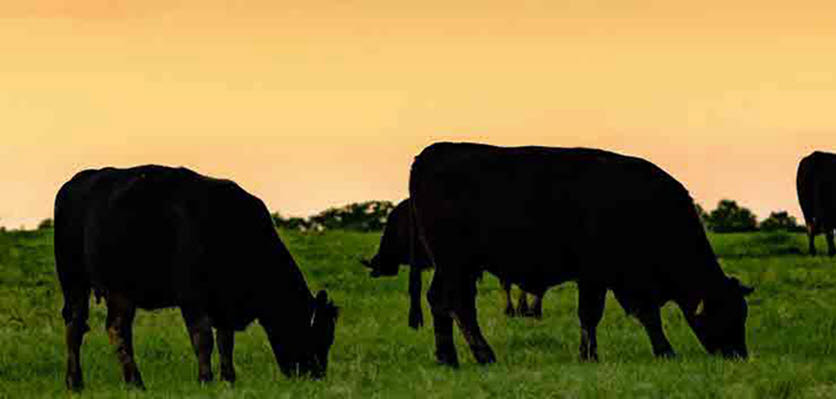Cattle nutrition and digestion

Cattle are ruminants, which means they have a special digestive system that allows them to utilise plant material as their major source of nutrients. Their stomach contains four compartments; the rumen, reticulum, omasum and abomasum. Each compartment has its own unique function in the digestive process.
Rumen
The rumen is the largest compartment and acts as a storage and fermentation vat where large numbers of microorganisms help break down and convert plant material into volatile fatty acids which can be then used by the cow for energy. A large amount of gas is produced during the fermentation process, which is then eructated (burped) up by the cow. If they are unable to eliminate this excess gas, they will suffer from ‘bloat’ which is when the rumen becomes significantly distended with gas and can be fatal if the gas is not released. Veterinarians will commonly be called out to farms to treat cows suffering from bloat. The pH of the rumen is an important factor in supporting the health of ruminal microorganisms. These microorganisms prefer a pH range of between 6 and 7. Feeding cows a diet consisting of too much concentrates, such as grain, can result in a reduction of the rumen pH and an imbalance of the normal microorganism populations which then leads to a condition known as acidosis. This is why when cows are fed concentrated feed, farmers will carefully formulate the amount and frequency of what they feed to reduce the risk of their cows developing acidosis.
Reticulum
The reticulum is located at the front of the rumen, near where food empties into the stomach from the oesophagus. The reticulum plays an important role in the movement of feed in the rumen and from the rumen and into the omasum. If pieces of metal wire or nails get left on the ground in paddocks, it is not uncommon for cows to accidentally ingest these objects while they graze. This can lead to a condition known as traumatic reticuloperitonitis or ‘hardware disease’. This is when these metal objects get lodged within the reticulum and cause irritation and can even pierce the lining of the stomach wall. A cow’s heart is located very close to the stomach and these metal objects can sometimes even pierce through the stomach and into the sac surrounding the heart! If a cow becomes unwell, veterinarians will sometimes have to perform surgeries to remove these objects from the reticulum. To help prevent ‘hardware disease’, veterinarians may also use special magnets which are placed via a stomach tube into the rumen. These magnets then attract the metal objects and help prevent them piercing the stomach lining.
Omasum
The main function of the omasum is to absorb water as well as some nutrients. It has many folds, known as laminae, which increase the surface area and help maximise the amount of water absorbed. The omasum also provides passage of smaller food particles into the abomasum for the final step of stomach digestion.
Abomasum
The abomasum is the final compartment of the ruminant stomach and is the compartment most similar to the stomach found in carnivores and humans. This is the glandular stomach which produces gastric enzymes to digest proteins chemically. The pH of the abomasum is between 2 and 3, which is much more acidic than the rumen. In some cows, the abomasum can move and become displaced. This can occur to either the left (LDA) or to the right (RDA). Veterinarians can sometimes correct this displacement by rolling the cow on its back, however will often have to perform surgery to reposition the abomasum into its correct location. When surgery is performed the veterinarian will also often suture the abomasum to the abdominal wall to reduce the risk of it becoming displaced in the future.
In calves still drinking milk there is a special structure known as the ‘oesophageal groove’ which allows milk to skip the rumen and go straight from the oesophagus and into the abomasum for digestion. This special groove stops functioning once the calf is weaned off milk and onto a plant based diet.
Feeding
To have healthy and productive cattle herds, it is essential to ensure their nutrition meets their energy requirements. These needs vary between beef and dairy herds and requires precise management whether it’s a pasture based or feedlot system. Producing milk is a very energy intense process, so in addition to good quality pasture, dairy cows require additional supplementation in the form of concentrates to ensure their high energy demands are met. Veterinarians play a unique role in providing nutritional advice in the cattle industries as they understand the key role nutrition plays in the whole farm system. After all, happy, healthy animals are productive animals.
